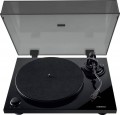Model
Model of the pickup (cartridge) supplied with the player. The pickup is one of the most important parts of any vinyl player, the quality of the received sound largely depends on its quality. Knowing the name of the model, you can find detailed data on it and determine how satisfied you are with this particular cartridge.
Output level
The signal level at the output of the pickup supplied with the player is, in fact, the power of the signal coming from the pickup to the phono stage. This parameter is necessary, first of all, in cases where the player is planned to be connected to an external phono stage: such equipment must be designed for the corresponding power of the signal coming from the pickup.
Downforce
The force of pressing the needle on the plate, which the complete pickup (cartridge) is designed for.
This force depends on the rigidity (compliance) of the needle: the greater the clamping force, the harder the cartridge, respectively, the less pliable it is. It is also believed that less pressing force wears out the record less, but it cannot be said that "light" cartridges are definitely better — there are many other nuances. So in fact, information about the pressing force of a complete pickup is needed mainly in case of its replacement. Usually, the pressing force provided by the arm of the turntable is regulated within these limits, so the new cartridge must also be rated for the same values of downforce — otherwise there is a chance that the turntable will not be able to correctly align.
Pickup weight
The weight of the pickup (cartridge) supplied with the turntable.
The weight of the cartridge determines the characteristics of balancing the tonearm to set the optimal tracking force. However, pickups in set are usually optimally compatible with the corresponding tonearms, so there are no problems with adjusting the turntable. But when buying a replacement cartridge, you should pay attention to this parameter: it is advisable that the new cartridge does not differ too much in weight from the old one, otherwise the tonearm adjustment range may not be enough for the correct balance.
Shape
The shape of the complete tonearm (viewed from on top). Modern players may have both
straight and
S-shaped or
J-shaped tonearms. It is impossible to say for sure which of them is better: the advantage of the first option is its light weight, the second and third ones are its greater length and low resonant frequency, which reduces the likelihood of interference. Therefore, in practice, the choice depends on the specific situation and personal preferences.
Tonearm effective length
The effective length of a tonearm in set is the distance from the attachment point (axis of rotation) to the stylus.
This indicator is important primarily for rotary tonearms: the longer the length, the lower the angular error, the smaller the discrepancy between the direction of movement of the track and the longitudinal axis of the pickup (for more details, see “Type”) and the lower the level of corresponding distortion. In addition, a longer length reduces the resonant frequency and reduces the likelihood of distortion. On the other hand, a longer tonearm turns out to be heavier, which requires certain technical tricks and can also negatively affect the purity of the sound. Therefore, a large length is not always a guarantee of high quality – you should also pay attention to weight (see below).
Tonearm weight
Operating weight of the complete tonearm. It is believed that this indicator should be as low as possible — in order not to create excessive pressure and to minimize the wear of the needle and records. On the other hand, a rigid pickup on a light arm can bounce on uneven records, and in general, such a discrepancy does not improve the sound quality. However, complete tonearms are usually optimally compatible with complete pickups; therefore, you should only be interested in compatibility when buying a cartridge of a different model.
External power supply
An external power supply is called a power supply unit (PSU) placed outside the player's case; such a unit can be connected to the outlet with a wire or plugged directly into it using its own plug. The point of this arrangement is to minimize possible interference from the power supply electronics by removing it to the maximum distance from the circuits through which the signal passes. Therefore,
an external power supply is considered the best option for audiophile class acoustics.
Phono stage
A phono corrector is a specially designed preamplifier used when working with vinyl record pickups. Initially, the sound on such records is recorded with distortion of the amplitude-frequency characteristic, namely with an increase in volume from low to high frequencies; this is due to the technical features of the recording process. Accordingly, the phono corrector not only amplifies the signal to a level sufficient for feeding to the power amplifier, but also corrects the amplitude-frequency characteristic, “pulling out” the bass and reducing the volume of the HF. And
the built-in phono corrector allows you to connect the player to the power amplifier directly, without using intermediate equipment. True, in terms of characteristics, built-in preamplifiers-correctors are inferior to external ones. Therefore, some models with this function may provide
a “bypass” mode, allowing you to pass the signal bypassing the built-in phono corrector to an external, more advanced one. And there are also
vinyl players without a phono corrector at all.

